-

新人教版高中英语选修2Unit 2 Using langauge-Listening教学设计
? B: Absolutely! Getting involved with Chinese cultural activities there definitely helped a lot. I got to practice my Chinese on a daily basis, and I could learn how native Chinese speakers spoke.? A: What do you feel is your biggest achievement?? B: Learning Chinese characters! I have learnt about 1,500 so far. When I first started, I didn't think it was even going to be possible to learn so many, but now I find that I can read signs, menus, and even some easy newspaper articles.? A: What are you most keen on?? B: I've really become keen on learning more about the Chinese culture, in particular Chinese calligraphy. As I have learnt Chinese characters, I have developed a great appreciation for their meaning. I want to explore Chinese characters by learning how to write them in a more beautiful way. ? A: Finally, what do you want to say to anyone interested in learning Chinese?? I have really become keen on learning more about the Chinese culture, in particular Chinese Calligraphy. As I have learnt Chinese character, I have developed a great appreciation for their meaning. I want to explore Chinese characters by learning how to write them in a more beautiful way.? A: Finally, what do you want to say to anyone interested in learning Chinese?? B: I'd say, give it a shot! While some aspects may be difficult, it is quite rewarding and you will be happy that you tried.? A: Thanks for your time. ? B:You're welcome.

新人教版高中英语选修2Unit 3 Using langauge-Listening教学设计
1. How is Hunan cuisine somewhat different from Sichuan cuisine?The heat in Sichuan cuisine comes from chilies and Sichuan peppercorns. Human cuisine is often hotter and the heat comes from just chilies.2.What are the reasons why Hunan people like spicy food?Because they are a bold people. But many Chinese people think that hot food helps them overcome the effects of rainy or wet weather.3.Why do so many people love steamed fish head covered with chilies?People love it because the meat is quite tender and there are very few small bones.4.Why does Tingting recommend bridge tofu instead of dry pot duck with golden buns?Because bridge tofu has a lighter taste.5 .Why is red braised pork the most famous dish?Because Chairman Mao was from Hunan, and this was his favorite food.Step 5: Instruct students to make a short presentation to the class about your choice. Use the example and useful phrases below to help them.? In groups of three, discuss what types of restaurant you would like to take a foreign visitor to, and why. Then take turns role-playing taking your foreign guest to the restaurant you have chosen. One of you should act as the foreign guest, one as the Chinese host, and one as the waiter or waitress. You may start like this:? EXAMPLE? A: I really love spicy food, so what dish would you recommend?? B: I suggest Mapo tofu.? A: Really ? what's that?

新人教版高中英语选修2Unit 4 Learning about Language教学设计
This section guides students to pay attention to the typical context of vocabulary use, helps students accumulate vocabulary around the key vocabulary of this unit, and uses the learned words and word chunks in different contexts to deeply understand their meaning and usage, so as to achieve the purpose of review and consolidation.The teaching design activities aim to guide students to pay attention to the typical context in which the target vocabulary is used, as well as the common vocabulary used in collocation, so that students can complete the sentence with correct words. In terms of vocabulary learning strategies, this unit focuses on cultivating students' ability to pay attention to collocation of words and to use word blocks to express meaning.For vocabulary learning, it is not enough just to know the meaning of a single word, but the most important thing is to master the common collocations of words, namely word blocks.Teachers should timely guide students to summarize common vocabulary collocation, such as verb and noun collocation, verb and preposition collocation, preposition and noun collocation, and so on.1. Guide students to understand and consolidate the meaning and usage of the vocabulary in the context, 2. Guide the students to use the unit topic vocabulary in a richer context3. Let the students sort out and accumulate the accumulated vocabulary, establishes the semantic connection between the vocabulary,4. Enable students to understand and master the vocabulary more effectivelyGuiding the Ss to use unit topic words and the sentence patterns in a richer context.

新人教版高中英语选修2Unit 4 Reading for writing教学设计
假定你是英国的Jack,打算来中国旅行,请你给你的中国笔友李华写一封信,要点如下:1.你的旅行计划:北京→泰山→杭州;2.征求建议并询问他是否愿意充当你的导游。注意:1.词数80左右(开头和结尾已给出,不计入总词数);2.可以适当增加细节,以使行文连贯。参考词汇:故宫 the Forbidden City;泰山 Mount TaiDear Li Hua,I'm glad to tell you that 'm going to visit China.First,I am planning to visit Beijing,the capitalof China,where I am looking forward to enjoying the Great Wall,the Forbidden City and somebeautiful parks.Then I intend to go to visit Mount Tai in Shandong Province.I've heard that it is one ofthe most famous mountains in China and I can't wait to enjoy the amazing sunrise there.After that,I amalso going to Hangzhou.It is said that it is a beautiful modern city with breathtaking natural sights,among which the West Lake is a well- known tourist attraction.What do you think of my travel plan? Will you act as my guide? Hope to hear from you soon.

新人教版高中英语选修2Unit 4 Using langauge-Listening教学设计
The theme of the listening section is " talking about scenery and culture along a journey."The part is designed to further lead the students to understand Canadian natural geography and social environment, and integrated into the cultural contrast by mentioning the long train journey from Beijing to Moscow routes. On this basis, the part activates students related travel experience, lets the student serial dialogue, guides the student to explore further the pleasure and meaning of the long journey, and Chinese and foreign cultural comparison.The part also provides a framework for the continuation of the dialogue, which is designed to provide a framework for students to successfully complete their oral expressions, and to incorporate an important trading strategy to end the dialogue naturally.1. Help students to understand and master some common English idioms in the context, and experience the expression effect of English idioms.2. Guide the students to understand the identity of different people in the listening context, and finish the dialogue according to their own experience.3. Instruct the students to use appropriate language to express surprise and curiosity about space and place in the dialogue, and master the oral strategy of ending the dialogue naturally.1. Instruct students to grasp the key information and important details of the dialogue.2. Instruct students to conduct a similar talk on the relevant topic.

新人教版高中英语选修2Unit 5 Learning about Language教学设计
The purpose of this section of vocabulary exercises is to consolidate the key words in the first part of the reading text, let the students write the words according to the English definition, and focus on the detection of the meaning and spelling of the new words. The teaching design includes use English definition to explain words, which is conducive to improving students' interest in vocabulary learning, cultivating their sense of English language and thinking in English, and making students willing to use this method to better grasp the meaning of words, expand their vocabulary, and improve their ability of vocabulary application. Besides, the design offers more context including sentences and short passage for students to practice words flexibly.1. Guide students to understand and consolidate the meaning and usage of the vocabulary in the context, 2. Guide the students to use the unit topic vocabulary in a richer context3. Let the students sort out and accumulate the accumulated vocabulary, establishes the semantic connection between the vocabulary,4. Enable students to understand and master the vocabulary more effectivelyGuiding the Ss to use unit topic words and the sentence patterns in a richer context.Step1: Read the passage about chemical burns and fill in the blanks with the correct forms of the words in the box.

新人教版高中英语选修2Unit 5 Reading and thinking教学设计
The theme of this activity is to learn the first aid knowledge of burns. Burns is common in life, but there are some misunderstandings in manual treatment. This activity provides students with correct first aid methods, so as not to take them for granted in an emergency. This section guides students to analyze the causes of scald and help students avoid such things. From the perspective of text structure and collaborative features, the text is expository. Expository, with explanation as the main way of expression, transmits knowledge and information to readers by analyzing concepts and elaborating examples. This text arranges the information in logical order, clearly presents three parts of the content through the subtitle, accurately describes the causes, types, characteristics and first aid measures of burns, and some paragraphs use topic sentences to summarize the main idea, and the level is very clear.1. Guide students to understand the causes, types, characteristics and first aid methods of burns, through reading2. Enhance students’ ability to deal withburnss and their awareness of burns prevention3. Enable students to improve the ability to judge the types of texts accurately and to master the characteristics and writing techniques of expository texts.Guide students to understand the causes, types, characteristics and first aid methods of burns, through readingStep1: Lead in by discussing the related topic:1. What first-aid techniques do you know of ?CPR; mouth to mouth artificial respiration; the Heimlich Manoeuvre

新人教版高中英语选修2Unit 5 Using langauge-Listening教学设计
The theme of this section is to learn how to make emergency calls. Students should learn how to make emergency calls not only in China, but also in foreign countries in English, so that they can be prepared for future situations outside the home.The emergency telephone number is a vital hotline, which should be the most clear, rapid and effective communication with the acute operator.This section helps students to understand the emergency calls in some countries and the precautions for making emergency calls. Through the study of this section, students can accumulate common expressions and sentence patterns in this context. 1.Help students accumulate emergency telephone numbers in different countries and learn more about first aid2.Guide the students to understand the contents and instructions of the telephone, grasp the characteristics of the emergency telephone and the requirements of the emergency telephone.3.Guide students to understand the first aid instructions of the operators.4.Enable Ss to make simulated emergency calls with their partners in the language they have learned1. Instruct students to grasp the key information and important details of the dialogue.2. Instruct students to conduct a similar talk on the relevant topic.Step1:Look and discuss:Match the pictures below to the medical emergencies, and then discuss the questions in groups.
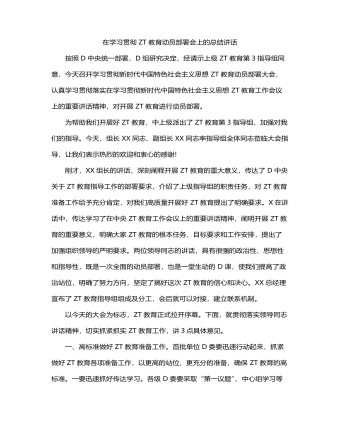
在学习贯彻主题教育动员部署会上的总结讲话
所属单位机关部门D组织ZT教育可以适当错后启动,拉开时间梯次,但也不能与上级单位间隔时间过长,最晚5月5日前要全面启动。需要强调的是,不管什么时间启动,具体到每个单位、部门,开展ZT教育的时间都不能少于5个月。无论采取哪种方式启动,都要讲清这次ZT教育的重大意义、目标要求、工作安排等。总公司机关各部门、所属各单位、各化工公司要将启动方案报巡回指导组审阅把关,巡回指导组还要现场参加指导各部门、各单位的启动工作。三、高水平进行ZT教育督促指导。强有力的督促指导是搞好ZT教育的重要保证,要把严督实导贯穿指导开展ZT教育全过程。按照D中央要求,总公司所属各单位不再派出指导组。这对总公司巡回指导组来说,担子更重了,既要直接指导所属各单位和化工公司本级D委,又要延伸指导所属单位机关部门、直属单位D组织。
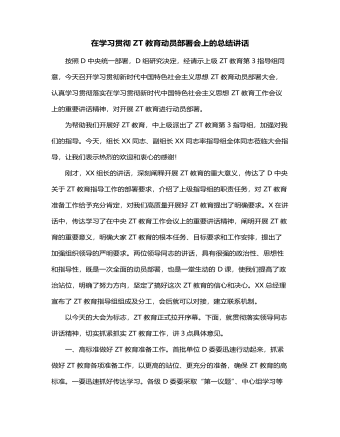
在学习贯彻主题教育动员部署会上的总结讲话
无论采取哪种方式启动,都要讲清这次ZT教育的重大意义、目标要求、工作安排等。总公司机关各部门、所属各单位、各化工公司要将启动方案报巡回指导组审阅把关,巡回指导组还要现场参加指导各部门、各单位的启动工作。三、高水平进行ZT教育督促指导。强有力的督促指导是搞好ZT教育的重要保证,要把严督实导贯穿指导开展ZT教育全过程。按照D中央要求,总公司所属各单位不再派出指导组。这对总公司巡回指导组来说,担子更重了,既要直接指导所属各单位和化工公司本级D委,又要延伸指导所属单位机关部门、直属单位D组织。要把准巡回指导工作定位,切实尊重各单位D委主体地位,紧紧依靠他们开展工作,既指出存在问题又要帮助研究对策,真正实现同题共答。

乡2023年政法信访工作总结及2024年工作谋划
2024年,乡将以创造安全稳定的政治社会环境为主线,紧紧围绕着平安建设、法治建设,在综治维稳、社会治理、服务群众上下功夫,推动政法工作高质量发展,高水平跃进。一是积极化解各类矛盾,全力维护社会稳定。正确处理人民内部矛盾。建立矛盾纠纷排查调处机制,认真做好矛盾分类梳理和调处工作,及时准确地掌握可能引发不稳定案件的苗头,做到早发现、早报告、早疏导、早化解,力求把问题解决在基层,消化在内部,化解在萌芽状态。对涉法涉诉上访案件不回避、不推拖,对不合理诉求,做好耐心细致的解释说服工作,对合理诉求,给予及时处理。二是着力做好社会治理现代化。一要高规格推进市域社会治理现代化。要进一步做细网格服务管理,推动创建服务站,建立信息收集、下沉走访、信息融合、跟踪督办、考评激励机制等落实落地。

镇2023年法治建设工作总结和 2024年工作计划
三、下一步工作计划我镇将继续深入学习贯彻A法治思想,全面贯彻落实中央、省委、州委和县委法治建设有关会议要求,按照“八五”普法要求继续深入学习,全面抓好依法治镇各项重点工作。一是推进规范化建设,增强依法行政意识。坚持领导干部带头学法,继续坚持中心组集体学法、领导干部法制讲座、重大决策前学法或法律咨询等制度,使领导干部法制学习制度化、规范化。坚持以考促学,不断强化领导干部学法用法工作。二是完善行政执法制度,规范行政执法行为。加强规范行政执法行为和提高行政执法效能的制度建设,以制度规范行为,以考评落实制度。强化执法队伍培训,迅速适应在新的执法体制环境下开展行政执法工作,提高依法行政工作能力,推进行政执法体制改革创新目标实现。规范行政执法行为,确保法律、法规的正确实施,针对本部门工作人员,积极开展各项普法教育。
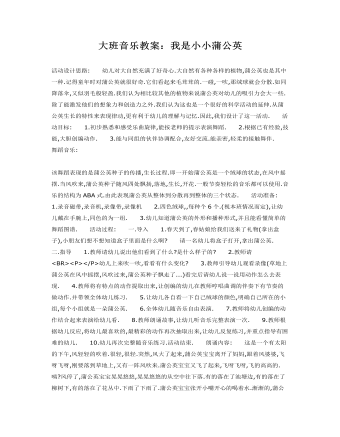
大班音乐教案:我是小小蒲公英
活动目标:1.初步熟悉和感受乐曲旋律,能按老师的提示表演舞蹈.2.根据已有经验,技能,大胆创编动作.3.能与同组的伙伴协调配合,友好交流.能亲密,轻柔的接触舞伴. 舞蹈音乐:该舞蹈表现的是蒲公英种子的传播,生长过程.即一开始蒲公英是一个绒球的状态,在风中摇摆.当风吹来,蒲公英种子随风四处飘扬,落地,生长,开花.一般节奏轻松的音乐都可以使用.音乐的结构为ABA式.由此表现蒲公英从整体到分散再到整体的三个状态. 活动准备:1.录音磁带,录音机,录像带,录像机 2.四色绒球,,每种个6个.(视本班情况而定),让幼儿戴在手腕上,同色的为一组.3.幼儿知道蒲公英的外形和播种形式,并且能看懂简单的舞蹈图谱. 活动过程:
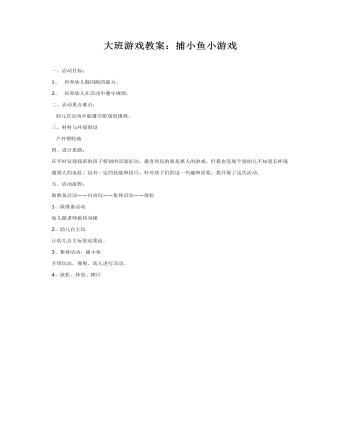
大班游戏教案:捕小鱼小游戏
二、活动重点难点: 幼儿在活动中能遵守游戏的规则。 三、材料与环境创设 户外塑胶地 四、设计思路: 在平时发现我班的孩子特别的活泼好动,最喜欢玩的就是抓人的游戏,但我也发现个别幼儿不知道怎样逃避别人的追赶,没有一定的技能和技巧。针对孩子们的这一兴趣和需要,我开展了这次活动。
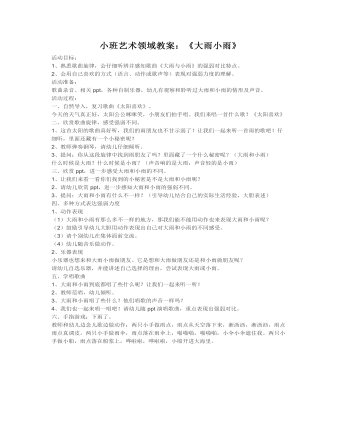
小班艺术领域教案:《大雨小雨》
2、会用自己喜欢的方式(语言、动作或歌声等)表现对强弱力度的理解。 活动准备: 歌曲录音、相关ppt,各种自制乐器,幼儿有观察和聆听过大雨和小雨的情形及声音。 活动过程: 一、自然导入,复习歌曲《太阳喜欢》。 今天的天气真正好,太阳公公咪咪笑,小朋友们拍手唱。我们来唱一首什么歌?《太阳喜欢》 二、欣赏歌曲旋律,感受强弱不同。 1、这首太阳的歌曲真好听,我们的雨朋友也不甘示弱了!让我们一起来听一首雨的歌吧!仔细听,里面还藏有一个小秘密呢? 2、教师弹奏钢琴,请幼儿仔细倾听。 3、提问:你从这段旋律中找到雨朋友了吗?里面藏了一个什么秘密呢?(大雨和小雨) 什么时候是大雨?什么时候是小雨?(声音响的是大雨,声音轻的是小雨)
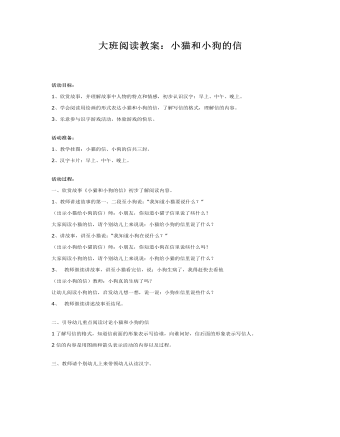
大班阅读教案:小猫和小狗的信
2、学会阅读用绘画的形式表达小猫和小狗的信,了解写信的格式,理解信的内容。 3、乐意参与识字游戏活动,体验游戏的快乐。 活动准备:1、教学挂图:小猫的信、小狗的信共三封。2、汉字卡片:早上、中午、晚上。 活动过程: 一、欣赏故事《小猫和小狗的信》初步了解阅读内容。 1、教师讲述故事的第一、二段至小狗说:“我知道小猫要说什么?” (出示小猫给小狗的信)师:小朋友,你知道小猫子信里说了些什么? 大家阅读小猫的信,请个别幼儿上来说说:小猫给小狗的信里说了什么?

黄梅戏《天仙配》选段《夫妻双双把家还》教案
黄梅戏是安徽省的主要地方戏曲剧种,原名“黄梅调”或“采茶戏”。流行于安徽、湖北、江西、江苏等地。他的起源大约可以追溯到清朝乾隆年间,但形成一个完整的剧种,是十八世纪后期在皖、鄂、赣三省毗邻的黄梅县形成的,其中一支逐渐东移到安徽省怀宁县为中心的安庆地区,与当地民间艺术相结合,用当地语言歌唱、说白,形成了自己的特点,被称为“怀腔”或“怀调”,这就是今日黄梅戏的前身。主要剧目有:《天仙配》、《夫妻观灯》、《打猪草》等。黄梅戏《打猪草》由“二小”组成,人物是陶金花、金小毛,一个打猪草一个看竹笋。陶金花在打猪草时.拔草用劲过大,不小心碰断了金小毛家两根竹笋,慌忙用草将笋盖上,这时,在树上看笋的金小毛看见了,认为她有意偷笋,踩破了她的篮子。小姑娘哭着拉他去见妈妈,要他赔篮子。金小毛无奈,将舅母让他买盐的二百文钱赔她,她知道底细后不要金小毛赔了,说:“只要心意好,人好水也甜”,金小毛又把断了的竹笋一起送她,陶金花提不动,又帮着她送到家里。一路上边走边唱盘歌《对花》,什么花都问遍了,终于回到家中,金花妈妈不在家,金花打了三个鸡蛋,泡一碗炒米招待小毛,小戏在欢乐的气氛中结束了。在封建礼教统治森严的情况下,男女青年这种自由交往具有反封建的意义,剧中所表现的青春的活力、逗趣的语言和优美的曲调,使人如沐春风,具有亲切感人的魅力。《打猪草》的可贵之处就在于毫无造作,从唱词到表演都再现了生活的真情,犹如田野吹来的风,清凉爽快,沁人心脾。
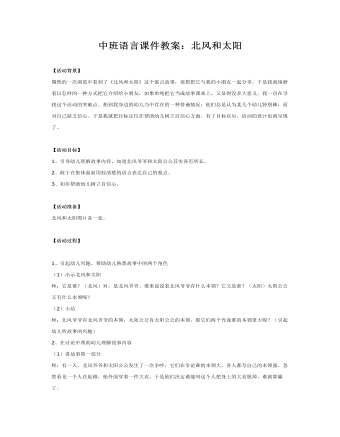
中班语言课件教案:北风和太阳
【活动目标】1、引导幼儿理解故事内容,知道北风爷爷和太阳公公其实各有所长。2、敢于在集体面前用较清楚的语言表达自己的观点。3、初步帮助幼儿树立自信心。 【活动准备】北风和太阳图片各一张。 【活动过程】 1、引起幼儿兴趣,帮助幼儿熟悉故事中的两个角色(1)出示北风和太阳师:它是谁?(北风)对,是北风爷爷。谁来说说看北风爷爷有什么本领?它又是谁?(太阳)太阳公公又有什么本领呢?(2)小结师:北风爷爷有北风爷爷的本领,太阳公公有太阳公公的本领,那它们两个究竟谁的本领更大呢?(引起幼儿听故事的兴趣)2、在讨论中帮助幼儿理解故事内容(1)讲故事第一部分师:有一天,北风爷爷和太阳公公发生了一次争吵,它们在争论谁的本领大,各人都夸自己的本领强。忽然看见一个人在赶路,他外面穿着一件大衣,于是他们决定谁能叫这个人把身上的大衣脱掉,谁就算赢了。
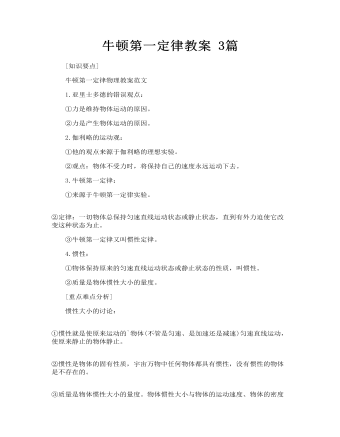
牛顿第一定律教案 3篇
①他的观点来源于伽利略的理想实验。 ②观点:物体不受力时,将保持自己的速度永远运动下去。 3.牛顿第一定律: ①来源于牛顿第一定律实验。 ②定律:一切物体总保持匀速直线运动状态或静止状态,直到有外力迫使它改变这种状态为止。

必修一牛顿第一定律教案
(二)?过程与方法? 4.?观察生活中的惯性现象,了解力和运动的关系? 5.?通过实验加深对牛顿第一定律的理解? 6.?理解理想实验是科学研究的重要方法? (三)?情感态度与价值观? 7.?通过伽利略和亚里士多德对力和运动关系的不同认识,了解人类认识事物本质的曲折性? 8.?感悟科学是人类进步的不竭动力





